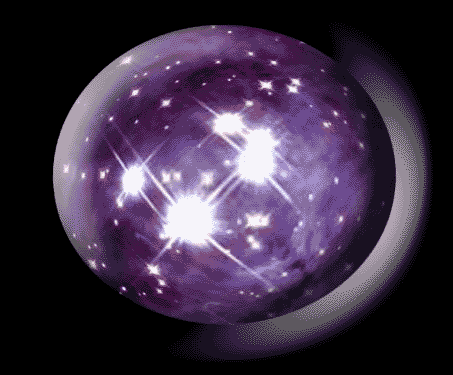Created By An Advanced Alien Civilization?
 MessageToEagle.com -
The captivating idea that we might be living in 3 dimensional
holographic simulation has been put forward by various scientists.
MessageToEagle.com -
The captivating idea that we might be living in 3 dimensional
holographic simulation has been put forward by various scientists.
We will explore this mind-boggling idea further and examine some intriguing questions.
If we suspect that we are programmed beings living inside a simulation is there any way for us to find out if this is true?
Is it possible to change the outcome of this virtual game?
Who could have created this matrix and for what reason? What are ancestor simulations?
Our whole world and our universe, might be a virtual reality matrix , programmed by the super-computer of a civilization of beings more advanced than we can possibly imagine.
Physicist Alain Aspect conducted a most remarkable experiment demonstrating that the web of subatomic particles that composes our physical universe - the so-called "fabric of reality itself" - possesses what appears to be an undeniable "holographic" property.
According to a recently theory proposed by Robert Lanza, author of "Biocentrism" - How Life and Consciousness are the Keys to Understanding the True Nature of the Universe death might not even be real! We might think that we are an advanced species, but we possess limited knowledge of the world around us.
We are moved by moved by neurophysiological signals and subject to a variety of biological, psychological and sociological influences over which we have limited control and little understanding. Suppose for a minute that we do live in a matrix and our reality is nothing but an illusion.

|

Nick Bostrom, Professor in the Faculty of Philosophy at Oxford University and founding Director of the Future of Humanity Institute and of the Programme on the Impacts of Future Technology within the Oxford Martin School presented his so-called simulation argument some years ago, and the theory is still widely debated among many scientists.
If we omit the mathematical part of the argument, it starts with "the assumption that future civilisations will have enough computing power and programming skills to be able to create what I call "ancestor simulations".
These would be detailed simulations of the simulators' predecessors - detailed enough for the simulated minds to be conscious and have the same kinds of experiences we have.
Think of an ancestor simulation as a very realistic virtual reality environment, but one where the brains inhabiting the world are themselves part of the simulation.
The simulation argument makes no assumption about how long it will take to develop this capacity. Some futurologists think it will happen within the next 50 years. But even if it takes10 million years, it makes no difference to the argument, " writes Bostrom in his paper "Do we live in a computer simulation?"
Bostrom says the conclusion is that at least one of the following three propositions must be true:
1. Almost all civilisations at our level of development become extinct before becoming technologically mature.
2. The fraction of technologically mature civilisations that are interested in creating ancestor simulations is almost zero.
3. You are almost certainly living in a computer simulation.
If we suppose that the first and second suggestion are false, then we can assume that a "signification fraction of these civilizations run ancestor stimulations."
 We could be holograms inside an ancestor stimulation.
We could be holograms inside an ancestor stimulation.We assume that technologically mature civilisations would have access to enormous amounts of computing power.
So enormous, in fact, that by devoting even a tiny fraction to ancestor simulations, they would be able to implement billions of simulations, each containing as many people as have ever existed. In other words, almost all minds like yours would be simulated.
Therefore, by a very weak principle of indifference, you would have to assume that you are probably one of these simulated minds rather than one of the ones that are not simulated, " Bostrom explains.
Bostrom also point out that his simulation argument does not prove that we are really living inside a stimulation, because we possess to little information to determine which one of the three is either true or false.
We cannot hope that the first assumption is false. Proposition number 2 requires convergence among all advanced civilisations, such that almost none of them are interested in running ancestor simulations.
"If this were true, it would be an interesting constraint on the future evolution of intelligent life," Bostrom says.
To many of us, option number two seems an unlikely scenario considering the vastness of the Universe and the number of advanced extraterrestrials species we could encounter if we had the means to travel among the stars.
 "If real is what you can feel, smell, taste and see, then 'real' is simply electrical signals
"If real is what you can feel, smell, taste and see, then 'real' is simply electrical signals interpreted by your brain," Morpheus - The Matrix movie
"What Copernicus and Darwin and latter-day scientists have been discovering are the laws and workings of the simulated reality. These laws might or might not be identical to those operating at the more fundamental level of reality where the computer that is running our simulation exists (which, of course, may itself be a simulation). In a way, our place in the world would be even humbler than we thought," Bostrom explains.
Why would an advanced civilization create a virtual world?
"If each advanced civilization created many Matrices of their own history, then most people like us, who live in a technologically more primitive age, would live inside Matrices rather than outside," Bostrom says.
We could be scientific experiment that is closely monitored by those alien beings who programmed the stimulation.
Even worse, we could be nothing more than a virtual game to our creators, in the same way we enjoy playing computer games. It is really impossible to tell.
How can we know if we are really living in a matrix?
If the simulators don't want us to find out, we probably never will. But if they choose to reveal themselves, they could certainly do so.
If the architects of this virtual reality want us to know we a holographic being living in a matrix, they can simply make a window pop up in our visual field with the text "YOU ARE LIVING IN A MATRIX. CLICK HERE FOR MORE INFORMATION".
"Another event that would let us conclude with a high degree of confidence that we are in a simulation is if we ever reach a point when we are about to switch on our own ancestor simulations. That would be very strong evidence against the first two propositions, leaving us only with the third, Bostrom says.
 Is it possible to escape the matrix? Image from movie The Thirteenth Floor
Is it possible to escape the matrix? Image from movie The Thirteenth Floor"If we knew the Architects' motives for designing Matrices then the hypothesis that we live in one might have major practical consequences. But in fact we know almost nothing about what these motives might be. We would run experiments, discover regularities, build models, and extrapolate from past events.
In other words, we would apply the scientific method and common sense in the same way as if we knew that we were not in a Matrix. To a first approximation, therefore, the answer to how you should live if you are in a Matrix is that you should live the same way as if you are not in a Matrix., " Bostrom says.
It would seem there is no way to escape the matrix... Even you think that you really managed to escape the matrix, how will you know it was not just a simulated escape?
@ MessageToEagle.com
Wonderfully Detailed Holographic Illusion
 MessageToEagle.com - In our daily life we are not aware that we may, in fact, live in a hologram and our existence
is a holographic projection, nothing more.
MessageToEagle.com - In our daily life we are not aware that we may, in fact, live in a hologram and our existence
is a holographic projection, nothing more.
All what we believe is real, our whole physical world, is - in fact - an illusion being proved by the holographic universe, one of the most remarkable theories of 20th century.
A theory that depending on which college textbooks or thesis studies you read, is either supported or has tried to be disapproved.
Energy fields are decoded by our brains into a 3D picture, to give the illusion of a physical world.
Despite its apparent materiality, the universe is a kind of 3-D projection and is ultimately no more real than a hologram.
"Our brain mathematically construct objective reality by interpreting frequencies that are ultimately from another dimension, a deeper order of existence that is beyond both space and time:
The brain is a hologram enfolded in a holographic universe!"
And this is an essence of Bohm and Pribram's theories which enable us to look at the world - in a new way.
Their theories challenge the educated mind at all levels, whether it be high school, college or another form of higher learning to not just take what is in different textbooks as truth but to form their own opinions and theories based off those written words and experiments. The idea is astonishing and even disturbing but was pioneered quite a long time ago by two of the world's most prominent scientists: American-born British physicist David Bohm (1917 - 1992), widely considered one of the best quantum physicists of all time and protégé of Albert Einstein and the quantum physicist and a neurophysiologist at Stanford University, Austrian-born, Karl Pribram, who, in fact predicted the holographic nature of perception and memory.

|
Both scientists were dissatisfied with standard theories that could not explain diverse phenomena encountered in quantum physics and puzzles related to neurophysiology of the brain.
A remarkable experiment was conducted in 1982, by a research team led by physicist Alain Aspect at the Institute of Theoretical And Applied Optics, in Paris.

The experiment demonstrated that the web of subatomic particles that composes our physical universe - the so-called "fabric of reality itself" - possesses what appears to be an undeniable "holographic" property.
The holographic theory of the world comprehensively includes not only reality as we know it but also unexplained phenomena.
It's capable to explain paranormal and out-of-body experiences, telepathy, "lucid" dreaming and much more. The holographic model has received much scientific and experimental support.
Aspect's experimental finding, is a compelling piece of evidence that the universe is a hologram and has never been - real. His experiment is one of the most important experiments of the 20th century and will probably change the face of science, forever.
Aspect, along with his colleagues Jean Dalibard and Gerard Roger discovered that under certain conditions subatomic particles such as electrons are able to instantaneously communicate with each other regardless of the distance separating them. It doesn't matter whether they are 10 feet or 10 billion miles apart. Somehow each particle always seems to know what the other is doing.

The problem with this feat is that it violates Einstein's long-held belief that no communication can travel faster than the speed of light.
Since traveling faster than the speed of light is tantamount to breaking the time barrier, this daunting prospect has caused some physicists to try to come up with elaborate ways to explain away Aspect's findings. However, it has inspired others to offer even more radical explanations, all based on assumption that objective reality does not exist, that despite its apparent solidity the universe is at heart a phantasm, a gigantic and wonderfully detailed hologram.
Karl Pribram realized that the objective world - does not exist, at least not in the way as we know it or as we see it.
"Out there", there are only waves and frequencies, which our brain convert for us into images, which make up our world. Our brain is responsible that we see things as we do!
Pribram asserted that our brain is able to construct objects and David Bohm even concluded that "we construct space and time".
Two great scientists had independent but common conclusions and it's make their theory of holographic universe so great!
But even, Bohm did not believe any theory to be correct in an absolute sense, including… his own.
We have to believe, precisely as David Bohm did, that at some point in the future, sophisticated techniques will be developed which will allow his own ideas and even others, to be tested and proved correct.








